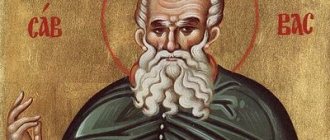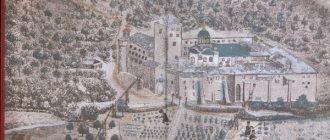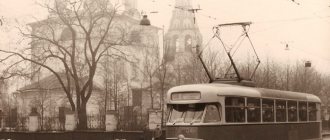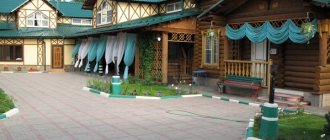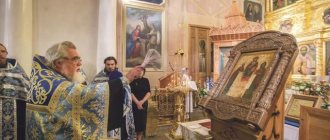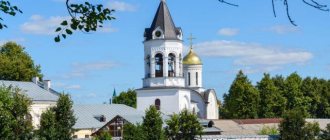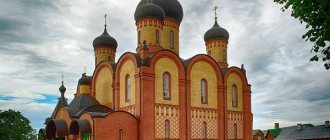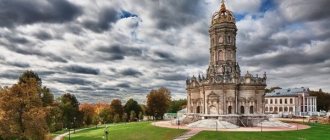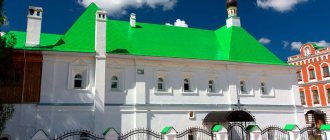Mir
Russia Perm region Belaya Gora village Belogorsky Nikolaevsky monastery Map loading in progress...
{"format":"leaflet","minzoom":false,"maxzoom":false,"limit":50,"offset":0,"link":"all","sort":[""], "order":[],"headers":"show","mainlabel":"","intro":"","outro":"","searchlabel":"\u2026 \u0441\u043b\u0435\ u0434\u0443\u044e\u0449\u0438\u0435 \u0440\u0435\u0437\u0443\u043b\u044c\u0442\u0430\u0442\u044b","default":"","import-annotation":false,"width ":"auto","height":"350px","centre":{"text":"","title":"""link":"""lat":57.39271000000000100271790870465338230133056640625,"lon": 56.2301250000000010231815394945442676544189453125,"icon":""},"title":"","label":"","icon":"","lines":[],"polygons":[],"circles":[ ],"rectangles":[],"copycoords":false,"static":false,"zoom":8,"defzoom":14,"layers":["OpenStreetMap"],"image layers":[] ,"overlays":[],"resizable":false,"fullscreen":true,"scrollwheelzoom":true,"cluster":false,"clustermaxzoom":9,"clusterzoomonclick":true,"clustermaxradius":80, "clusterspiderfy":true,"geojson":"","clicktarget":"","showtitle":true,"hidenamespace":false,"template":"","userparam":"","activeicon": "","pagelabel":false,"ajaxcoordproperty":"","ajaxquery":"","locations":[{"text":"\u003Cb\u003E\u003Ca href=\"/palomnik/%D0% 91%D0%B5%D0%BB%D0%BE%D0%B3%D0%BE%D1%80%D1%81%D0%BA%D0%B8%D0%B9_%D0%9D%D0%B8% D0%BA%D0%BE%D0%BB%D0%B0%D0%B5%D0%B2%D1%81%D0%BA%D0%B8%D0%B9_%D0%BC%D0%BE%D0% BD%D0%B0%D1%81%D1%82%D1%8B%D1%80%D1%8C\" title=\"\u0411\u0435\u043b\u043e\u0433\u043e\u0440\u0441\u043a\ u0438\u0439 \u041d\u0438\u043a\u043e\u043b\u0430\u0435\u0432\u0441\u043a\u0438\u0439 \u043c\u043e\u043d\u0430\u0441\u0442\u0 44b\u0440\u044c\»\u003E\ u0411\u0435\u043b\u043e\u0433\u043e\u0440\u0441\u043a\u0438\u0439 \u041d\u0438\u043a\u043e\u043b\u0430\u0435\u0432\u0441\u04 3a\u0438\u0439\u043c\u043e\ u043d\u0430\u0441\u0442\u044b\u0440\u044c\u003C/a\u003E\u003C/b\u003E\u003Chr /\u003E\u003Ca href=\"/palomnik/%D0%A1%D0%B2%D0% BE%D0%B9%D1%81%D1%82%D0%B2%D0%BE:%D0%90%D0%BD%D0%BD%D0%BE%D1%82%D0%B0%D1%86 %D0%B8%D1%8F\" title=\"\u0421\u0432\u043e\u0439\u0441\u0442\u0432\u043e:\u0410\u043d\u043d\u043e\u0442\u0430\u0446\u0438\u044f\ "" 36\u0435\u043d\u043d \u0430 \u043a\u0440\u0430\u044e \u0443\u0440\u0430\u043b\u044c\u0441\u043a\u043e\u0439 \u0411\u0435\u043b\u043e\u0439 \u043 3\u043e\u0440\u044b,\u0432 120 \u043a\u0438\u043b\u043e\u043c\u0435\u0442\u0440\u0430\u0445 \u043e\u0442 \u0433\u043e\u0440\u043e\u0434\u0430 \u041f\u0435 \u0440\u043c\u0438 \u0438 \u0432 40 443\u043d\u0433\u0443\u0440\ u0430. \u0417\u0430 \u0441\u0442\u0440\u043e\u0433\u043e\u0441\u0442\u044c \u0443\u0441\u0442\u0430\u0432\u0430 \u044d\u0442\u0443 \u043e\u0431\u0438\u0442\u0435 \u043b\u044c \u043d\u0435\u043a\u043e\u0433\u0434\u0430 \u043d\u0430\u0437\u044b\u0432\u0430\u043b\u0438 \u0423\u0440\u0430 \u043b\u044c\u0441\u043a\u0438 \u043c \u0410\u0444\u043e\u043d\u043e\u043c.","title":"\u0411\u0435\u043b\u043e\u0433\u043e\u0440\u0441\u043a\u0438\u0439 \u041d \u0438\u043a "Link":"""lat":57. 39271000000000100271790870465338230133056640625 ,"lon":56.2301250000000010231815394945442676544189453125,"icon":""}],,"imageLayers":[]}
57.391466; 56.225024
Russia, Perm region, Kungur municipal district, Belaya Gora village, Monastyrskaya street
Belaya Gora village, Perm region
Russia
Phones
Belogorsky St. Nicholas Orthodox Missionary Monastery
located on the edge of the Ural White Mountain, 120 kilometers from the city of Perm and 40 kilometers from the city of Kungur. For the strictness of the charter, this monastery was once called the Ural Athos.
History[edit]
Photo dated January 1, 1904.
In 1891, in memory of the “miraculous deliverance of Tsarevich Nicholas from danger in Japan,” a seven-foot cross, popularly nicknamed the Tsar’s cross (height 10 m 65 cm), was erected on White Mountain.
The site for the foundation of the temple on White Mountain was consecrated on June 18, 1893. Construction of the first wooden church was completed in February 1894. Also in 1894, construction began on the rector's and fraternal buildings, which later housed a carpentry and metalworking workshop. A school was opened to educate orphan boys; until 1917, 25 orphans were educated on White Mountain. At the monastery school, children were taught literacy, church singing, and various crafts.
On September 16, 1897, the first procession of the cross arrived on the White Mountain; five holy icons were delivered from Moscow and St. Petersburg to the White Mountain:
likeness of the Kazan Icon of the Mother of God
image of St. Sergius of Radonezh
image of the Kazan Mother of God, painted by monks of the Valaam Monastery
image of the holy noble prince Alexander Nevsky
image of the Mother of God “Novices”
But three years after construction, on November 16, 1897, the wooden temple completely burned down. In the same 1897, construction of a stone two-story building for the older brethren began.
The laying of the new stone church (Cathedral of the Exaltation of the Cross) took place on June 24, 1902. The construction of the temple lasted 15 years; at the end of construction, the temple could accommodate 8 thousand people. The chief engineer of the project was E.I. Artyomov, the building material was supplied by the monastery brick factory. The temple was completed and opened in 1917, the consecration of the temple lasted from June 7-9, about 30 thousand people attended the consecration ceremony.
During an audience with Emperor Nicholas II on December 8, 1910, Belogorsk Archimandrite Varlaam gave him a book about the history of the monastery and photographs of the monastery. In 1912, the Belogorsky Monastery published the magazine “Voice of Duty” with an Orthodox-patriotic orientation.
During the First World War, the Belogorsk Monastery donated (03/19/1916) 500 rubles in gold coins to the needs of the Russian army.
Holy Cross Cathedral
Cathedral of the Exaltation of the Cross before the revolution
The Exaltation of the Cross Cathedral was built in the neo-Byzantine style, modeled on the Vladimir Cathedral in Kyiv. From the very beginning, the temple was equipped with ventilation and steam heating.
The monumental cathedral, the most grandiose in the Perm diocese, was built both with donations from private individuals and at the expense of the monastery itself; according to the monastery’s reports for 1909, the monastery was engaged in arable farming, cattle breeding, beekeeping and fishing, the monastery owned 580 acres of land, had 40 cows and 9 ponds.
Soviet time
Tragic events struck the monastery already in 1918. On August 25, 1918, the Bolsheviks tortured and threw Archimandrite Varlaam into the Kama River. From August 1918 to January 1919, the Bolsheviks shot and tortured 34 monks of the Belogorsk Monastery.
On February 24, 1919, the white troops of General Verzhbitsky, having made a forced march from Kungur, liberated White Mountain from the Bolsheviks. By this time, the Bolsheviks had destroyed and plundered the monastery. A few months later, on July 1, 1919, the Bolsheviks captured Perm, and soon the entire Perm region; four years later, in March 1923, the monastery was finally closed.
Since 1930, a camp for repressed and special settlers was opened on Belaya Gora, and a home for the disabled was opened a year later. In 1941-1945, a rehabilitation center for wounded and disabled people of the Great Patriotic War was located on Belaya Gora. From 1946 to 1986, on White Mountain there was a home for disabled people of the Great Patriotic War, labor and childhood. In 1980, a fire broke out in the Belogorsk Cathedral, which severely damaged the temple; in particular, almost all the domes of the temple burned down.
White Mountain is an extraordinary place
The monastery received its name in honor of Mount Belaya, so named because snow that does not melt for a long time covers the peak with a white cap until the summer. And in winter it is white and white from the kitchen: shaggy frost abundantly and intricately covers the branches of the trees.
White Mountain is beautiful. When you stand at the top, you see an ocean of forest under your feet, stretching for 100 kilometers. In the vast expanse, everything vain and petty dissolves without a trace, doubts and worries leave.
The mountain is called a place of power. Here are underground springs of small rivers and healing springs. Groundwater rarely rises to higher elevations, and the White Mountain is saturated with springs: 13 streams flowing from the slopes turn into rivers.
From the top comes a spring, consecrated in the name of St. Nicholas the Wonderworker . A wooden staircase leads to the holy spring, and nearby there is a chopped chapel-font. Healing water is collected in a tiny chamber.
At the top there are wooden pagan temples, under the slopes there are secret grottoes. Escaped convicts hid here, wanting to live quietly and freely. The Belogorsky Monastery was founded here.
They say that the mountain does not allow everyone. On the way to Belogorye, cars and buses often break down, and the weather often deteriorates sharply on the road, but if you are allowed into the Belogorsk Territory, the impression will be unforgettable.
Current state[edit]
The beginning of the revival of the monastery is considered to be 1988-1989, when the 1000th anniversary of the Baptism of Rus' was celebrated. On January 29, 1991, the Holy Synod granted the request of Archbishop Athanasius of Perm and Solikamsk for a blessing to open the St. Nicholas Monastery on White Mountain, where monastic life was resumed.
On May 26, 1991, the first divine service in the reviving monastery was held in the upper church of the Cathedral of the Exaltation of the Cross.
With the arrival of His Eminence Methodius, Metropolitan of Perm and Solikamsk, to the Perm See in 2010, the pace of restoration of the Cathedral of the Exaltation of the Cross of the Belogorsk Monastery accelerated. Control over the progress of restoration work was transferred to the diocesan construction department, which was created in the Perm diocese by Bishop Methodius.
In 2011, the website of the Belogorsk Monastery “Ural Athos” (https://www.uralafon.perm.ru) was created, and the monthly newspaper “Voice of Duty” began to be published. The monastery is often visited by pilgrims.
Where is the Belogorsky Monastery located?
The Perm region is very rich in various religious shrines, among which one can note the quite famous Belogorsky Monastery, the distance to which from Voronezh is 165 km, from Belgorod - 314 km and from Volgograd - 517 km.
Address of the Belogorsky Monastery: Perm region, Voronezh region, Podgorensky district, Belogorye village, Kirpichi village, Alexander Nevsky street, 1.
- Telephone number of the Belogorsky Monastery: +7 (47394) 52-3-21,
- cell phone
How to get there[edit]
The monastery is located 100 kilometers from Perm and 12 kilometers from the nearest administrative center - the village of Kalinina. The road is in relatively good condition, which allows you to get from Perm to White Mountain in 1.5-2 hours. The most popular means of transport on this route is the Perm - Kalinino regular bus. It departs from the city bus station, which is located in the center of Perm, near the Central Market, and makes two trips a day: at 7:20 and 14:40. You can get from Kalinin to the monastery by car of a local resident, negotiating for a small fee. Those who are healthy enough can “climb” the White Mountain on foot, spending two to three hours.
Address
Russia, Perm region, Kungur district, Belaya Gora village, Monastyrskaya street, 1
Read also
4 best weekend routes around the Urals in winter
The Urals are undoubtedly a treasure trove of amazing nature and unique sights. You can travel around our region in summer, winter, and autumn, … Read more
Silence of the White Mountain
Grandiose plans for epic trips during the New Year holidays went down the drain - members of the household (including me) showed weak immune systems and came down with snot... Find out more
Where to go for the long weekend on March 8?
Of course, this weekend is not that long if you compare it with the New Year holidays... But still, in my opinion,... Find out more
The history of the creation of the Belogorsk Monastery
The idea of creating the Belogorsk monastery appeared around 1796 , when Maria Sherstyukova, the daughter of the Ukrainian Cossack Konstantin Bosogo, decided, with the blessing, to found a community that began digging caves in the slopes of the mountain and eventually took on the role of abbess of the monastery. During her lifetime, approximately 212 meters of caves were dug. Both the abbess’s associates and she herself took part in the digging. By the beginning of the 20th century, the total length of the caves was 2 km. At the same time, religious buildings of the monastery were erected. In 1875, the Belogorsk monastery, even before the appearance of the monastery, had its own abbot - Hieromonk Peter, who was distinguished by his energy, severity and at the same time kindness. Church of the Resurrection was founded . His petitions to create a monastery were approved, and already in 1882 the Synod approved the monastery. There were a lot of donations of both land and material resources.
Start of construction
A ceremonial prayer service and illumination of the construction site took place in 1893, on June 18. Marking the site on White Mountain, plans and drawings - everything was prepared in advance. In 1894, the Belogorsky Monastery had already begun to work, since the temple had already been completely rebuilt, although it was still wooden. Then work continued on the buildings that would house the monks, various utility rooms, the abbot's room, etc. They also opened a school for orphans, where 25 boys lived and were educated. An interesting detail: the Belogorsk Monastery was self-supporting. The monks, mastering peasant skills (and many were familiar with them from childhood), plowed and sowed, gardened, raised livestock and poultry, and were engaged in fishing and beekeeping. Fulfilling their Christian duty, they helped the surrounding population with food free of charge. During the lean years, the monastery bread saved many people!
Schedule of services at the Belogorsk Monastery
From Monday to Friday 06:00 – A prayer service and morning prayers are held, then the Midnight Office, Matins and the Liturgy. 18:00 – Ordinary Vespers and Little Compline with the canon to the Most Holy Theotokos, and evening prayers are also said. Saturday 07:30 – Time for morning prayers, midnight office, liturgy and memorial service. 18:00 – The usual all-night vigil takes place. On Sundays and holidays 07:30 – Time for morning prayers, midnight office, liturgy and a prayer service is said.
What is the best way to get to the Belgorod Monastery
In order to get to the Belgorod Monastery, you can use several types of transport that are suitable for travelers with different financial status. How to get there by car
- Getting there from Voronezh, you should follow the M4 highway, which will lead to a sign for Rossosh, Belogorye, Babka, about 15 km before reaching Pavlovsk. After this turn, you still need to drive about 7 km to Belogorye. Having contacted the abbots of the Trinity Church in the village of Belogorye, follow their instructions on which route is best to get to the monastery. Depending on the chosen route, you will need to travel another 3 to 10 km to reach the Kirpichi village.
- When getting along the Voronezh - Lugansk highway from Ostrogozhsk, you need to get to the village of Podgorensky. At the end of the village, not far from the cement plant, you should turn towards Pavlovsk, before reaching which about 30 km there will be the village of Belogorye, where in the Trinity Church they will tell you the further way to the monastery.
How to get there by train Any electric train or passenger train that stops at Podgornoye station. Then you should take a minibus to Pavlovsk, on the way to which you will need to get off in the village of Belogorye. How to get there by bus Almost any bus goes to the village of Belogorye in the direction of Pavlovsk, Rossosh, Olkhovatka or Podgorny. For example, you can get from Voronezh by bus to Rossosh at 8:00, 14:55 and 16:30, to Podgorensky at 11:20 and 15:20. From Belogorye to the village of Kirpichi it is about 3 km, which you can either walk or ask one of the locals to take you. How to get there by boat A passenger boat offers its services to pilgrimage groups of up to 50 people, delivering travelers to the monastery, on the way to which the beauty of the Don River awaits them. In this case, you need to book your tickets in advance, which can be ordered by calling:
- 8 (47362) 7-13-63,
- 8 (47362) 2-54-47,
- 8 (47362) 2-53-47
- or cell phone: 8-903-030-68-12.
Holy place
Yes, the popular proverb is right when it says that a holy place will not be empty. And during the perestroika period, when a revaluation of values took place, not only forgotten or crossed out names of figures of literature, music, painting, undeservedly forgotten works of art, but also religious centers were returned to Russian culture. So the Belogorsky Monastery, or rather, everything that was left of it, again went under the authority of the Orthodox Church. The solemn celebration of the day of the baptism of Rus' played a large role in this important event. The necessary amounts were allocated from the central and regional budgets. And restoration work began again both on all the buildings of the monastery and in the main attraction of the complex - the Cathedral of the Exaltation of the Cross. Every cloud has a silver lining - thanks to modern technology, a natural spring with healing water was discovered on the territory of the monastery, which further glorified and made these places popular.
